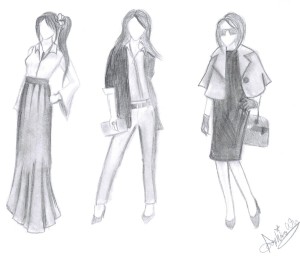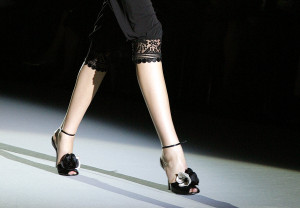- Calls to this hotline are currently being directed to Within Health or Eating Disorder Solutions
- Representatives are standing by 24/7 to help answer your questions
- All calls are confidential and HIPAA compliant
- There is no obligation or cost to call
- Eating Disorder Hope does not receive any commissions or fees dependent upon which provider you select
- Additional treatment providers are located on our directory or samhsa.gov
Advocacy and Advertising
Contributor: Leigh Bell, BA, writer for Eating Disorder Hope

Moss was an easy target. She was super thin. And it was she who said: “Nothing tastes as good as skinny feels.”
While Moss may have been falsely accused of causing eating disorders, models after her generally slimmed down their already thin frames until it seemed skeletons and skin were on catwalks and in fashion magazines.
Pushing Back Against the Thin Trend
Even some in the industry agree it’s gone too far, joining advocates for healthier female images in advertising. A few years ago, Vogue editors worldwide promised not to use models with obvious signs of an eating disorder1. France recently stood with Italy, Spain, and Israel up against super-skinny models and passed a law requiring a healthy Body Mass Index of its catwalkers.
Dove’s “Campaign for Real Beauty,” turned upside down the advertising world, and Aerie, the undergarment sister brand to American Eagle, launched the Aerie Real campaign, refusing to retouch its models and promising its 15-to-21-year-old-female target group will finally see models without photoshop.
It’s an exciting momentum, driven by dogged media advocacy groups, to redefine beauty and send healthier messages through advertising.
Models Are Getting Thinner

In fact, many models these days are thinner than the criteria for anorexia, and this ideal is “pervasive, with fashion models, cartoon characters, and Miss America Pageant winners all having become increasingly thinner over the past decades,” according to a meta-analysis of women’s body image and media3.
Advocacy groups fight this trend because children starting at age 8 watch between 3 1/2 to 5 hours of television each day, according to the Center on Media and Child Health, aimed for children to positively consume media.
How Exposure to Media Influences Our Body Image
The average American is exposed to more than 3,000 advertisements a day and watches three years worth of TV ads over the course of a lifetime4 Why the worry? One too-thin model in one ad can snowball, and maybe it already has, into a threat for everyday women.
The more we are exposed to media, the more we begin to accept media’s portrayal as reality. When the media representations of women’s bodies are so skewed — an out-of-reach ideal for most — adopting this reality chisels away at women’s body satisfaction. About half of girls and young women are already dissatisfied with their bodies, regardless of body size and race, and body dissatisfaction is “one of the most consistent and robust risk factors for eating disorders and a significant predictor of low self-esteem, depression, and obesity.” (Grabe, 2008)
The Standoff Between Advertising and Advocacy

Dove set off to embrace women’s differences, encourage self-confidence, and sell beauty products. The campaign showed the advertising world another perspective, lifted up women around the glove, and increased Dove’s sales by billions of dollars.
How Advertisers and Advocates Can Work Together
The Aerie Real campaign is also turning heads, especially that of the National Eating Disorders Association (NEDA), which a few months ago gave Aerie its first “Seal of Approval.” Companies may be catching on to what research already uncovered. Women had less body-focused anxiety after seeing attractive, average-sized models than after seeing no model at all — so seeing normal-sized women, even beautiful ones, could relieve anxiety (Grabe, 2008).
Advertisers may also note research shows when average-size models and ultra-thin models are equally attractive, they also appear to be equally effective endorsing a product6.
Community Discussion – Share your thoughts here!
What changes have you witnessed in advertising today that have impacted your body image? Did these changes impact you positively or negatively?
About the Author:
Leigh Bell holds a Bachelor of Arts in English with minors in Creative Writing and French from Loyola Marymount University in Los Angeles. She is a published author, journalist with 15 years of experience, and a recipient of the Rosalynn Carter Fellowship for Mental Health Journalism. Leigh is recovered from a near-fatal, decade-long battle with anorexia and the mother of three young, rambunctious children.
References:
- Wilson, E. (2012, May 3). Vogue Adopts a 16-and-Over Modeling Rule. Retrieved June 18, 2015
- National Eating Disorder Association Unveils Powerful & Provocative Ad Campaign, National Eating Disorders Association. (2009, February 26). Retrieved June 12, 2015.
- Grabe, S., Ward, L., & Hyde, J. (2008). The role of the media in body image concerns among women: A meta-analysis of experimental and correlational studies. Psychological Bulletin, 134(3), 460-476.
- Kilbourne, J. (2000). Can’t buy my love: How advertising changes the way we think and feel. Free Press.
- Skene, K. (2014, April 11). A PR Case Study: Dove Real Beauty Campaign. Retrieved June 12, 2015.
- Dittmar, H., & Howard, S. (2004). Thin-ideal internalization and social comparison tendency as moderators of medial models’ impact on women’s body focused anxiety. Journal of Social and Clinical Psychology, 23, 768-791.
Last Updated & Reviewed By: Jacquelyn Ekern, MS, LPC on July 1st, 2015
Published on EatingDisorderHope.com
